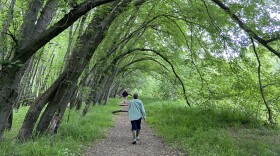Even if you’ve been living in New Hampshire for a long time, you may not know about a Seacoast forest that is only visible once or twice a day.
Visit Odiorne Point State Park in Rye when the tide is very low, and you can see remnants of a drowned, often called sunken, forest. Walk across the rocky shore by Periwinkle Cove at the park’s south end, and wade into the shallows. There you'll find tree stumps that look like they might have been alive a year or two ago, but they're actually closer to 4000 years old.
The wet stumps, and other evidence from the Isles of Shoals, five miles out in the Atlantic, tell a remarkable story about New Hampshire’s ancient coastline. Some relatively new discoveries, and new technologies, are helping to refine the picture.
Imagine it’s 12,000 years ago, and you’re standing at what we now call Odiorne Point. Perhaps 8,000 years before that, land that was compressed under the weight of glacial ice had begun to emerge.
As the ice melted across the Northern Hemisphere, sea levels rose and the Atlantic waters gradually crept inland. New Hampshire’s coastline receded all the way to present-day Durham and Lee, NH. That’s over 10 miles inland!
And then, after the glaciers melted, the Earth’s surface slowly ‘rebounded’ over thousands of years. Relieved of the weight of all that ice, the land actually gained elevation, and the coastline retreated all the way out to beyond the Isles of Shoals.
So for a time, the area where Odiorne Point is now was a forested coastal wetland. The Isles of Shoals would have been low hills on the eastern horizon overlooking the Atlantic Ocean.
Stumps seen only at low tide in Periwinkle Cove are remnants of an ancient forest of pine, hemlock and Atlantic White Cedar which grew here some 3500 to four thousand years ago, until it was drowned again by encroaching salt water.
The present day seabed has also revealed clues about New Hampshire’s wildlife ten thousand years ago: fossilized mastodon and wooly mammoth bones.

“There were mammoths and mastodons walking through Durham and through the Seacoast and all through New Hampshire. There's no question about it,” says Will Clyde, a geology professor at the University of New Hampshire.
“I tend to study periods that are much further in the past, and I don't tend to work in New Hampshire much,” Clyde says, but he is lucky enough to have fishermen visit his office when they find something odd amid all the stones and shells of a drag net.
“There's quite a few specimens that have been discovered by fishermen in the relatively shallow area there,” he says. “And that includes teeth, that includes ribs, that includes a beautiful specimen a few years ago that was a juvenile. It was a baby mastodon.”
More and more often specimens are brought into Clyde’s office with the GPS coordinates pinpointing where they were found. This has led to new developments: “We found a few spots where there's really a concentration of specimens. So we're actually doing some work to get some very detailed maps, sonar maps, of those areas. And we're hoping to send down some cameras to look at some of these areas.”
Clyde says a pattern showing a concentration of bones in one area could be a skeleton or more than one animal in a group.
Both tree stumps and mastodon bones and teeth show that our coastline has always been dynamic over thousands of years. But we’re seeing the rate of change accelerating. “As a geologist, this is a very short time scale. And now just in our own lifetimes, we're being challenged by the movements of the shoreline because of sea level change. The geological effects of climate change, these are all very active processes that we're able to observe in almost real time at this point.”
Understanding this time scale is critical;12,000 years is like the blink of an eye in geologic terms. And today’s coastal changes are likely to take place even faster, as the world’s massive glaciers – the Greenland ice sheet and the vast Antarctic ice shelves – retreat over mere decades.
Something Wild is a partnership of the Forest Society, NH Audubon, and NHPR and is produced by the team at Outside/In.











